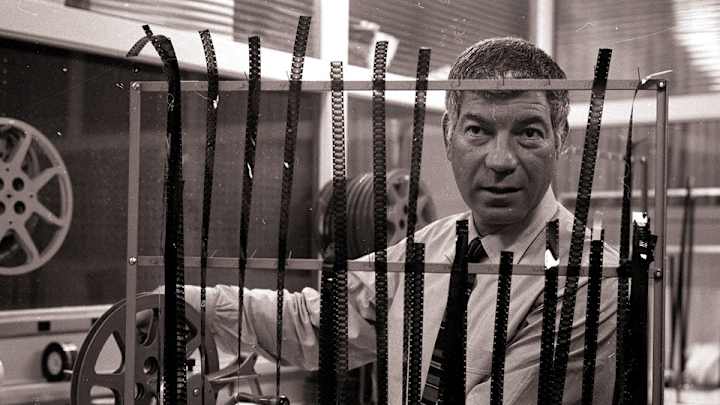Ed Sabol’s Presence Is Everywhere

Over the past five months I’ve watched my roommate, an Aussie named Ashleigh, fall in love. It began with flirtation, but each weekend her involvement intensified. Ashleigh is smitten with football—she calls it "gridiron"—and I don’t know if she’ll go back to rugby again.
Last week, I came home to find her curled up on the couch, watching a mic’d up Super Bowl clip. She’s now a woman obsessed.
“Em, you have to see this," she said, gaping at her laptop. It was the aftermath of Malcolm Butler’s interception, in epic intimacy: Russell Wilson fumbling for words, Marshawn Lynch smirking, and Tom Brady embracing Julian Edelman while professing, “I love you man."
“And wait, this one is amazing,” Ashleigh interjected, now opening a clip where Michael Bennett complains to the ref about Sebastian Vollmer during a stoppage.
“I have three kids,” Bennett tells the ref. “I love my kids. I love my daughters, I want to play with them after football. But you gotta call it both sides, man.”
“You’re right,” the ref says. “How old are they? How old are the kids?
“My kids are 8, 3, and 1,” Bennett says.
(At this point, Ashleigh is giggling hysterically.)
“Are you going to take them to Disney World?” the ref asks.
“I want to take them everywhere, but I can’t do it if he keeps pulling at my facemask!” Bennett replies.
I asked Ashleigh how often she watches footage like this. “Oh, every Monday," she replied, casually. “It makes the players human. It’s why I love the game.”
Selfishly, I always assumed Ash liked football because of me. Only then did I realize it wasn’t me who played cupid for Ashleigh and the gridiron. But rather, it was a man she never met.
* * *
Ed and Steve Sabol, in the archive warehouse at NFL Films headquarters in Mount Laurel, N.J., in 1984 (Ronald C. Modra/Sports Illustrated)

Ed Sabol, the father of NFL Films, passed away Monday at his home in Arizona. He was 98. The way he visualized football changed the sport forever. Ed founded the company that became NFL Films in 1962 and his son, Steve, served as president until his death in 2012. Many of their innovations—the slow-motion replay; low-angle shots; microphones on coaches, players and refs—now seem innate to the way we see football on the screen, but their impact cannot be understated. They were directors, the gridiron their stage, and by adding a dramatic flair and intimate touches, they made the sport accessible to everyone—even imports like my roomate Ashleigh, from a town called Wagga Wagga in New South Wales.
Ed Sabol’s affinity for drama was inherent. A former coat salesman, he talked his way into a partnership with the NFL. His production company, Blair Motion Pictures, bought the rights to the NFL championship game in 1962 for $5,000. The league was so impressed with Sabol’s footage that a year later it bought his company.
Sabol believed that football could be riveting cinema. If Bart Starr lobbed the ball downfield, Sabol wanted viewers to feel the tension to build with each spiral (captured with tight, low-angle shots). He wanted a stirring soundtrack, a dramatic conflict. He needed a villain and a protagonist, a reason for someone like Ashleigh to invest, deeply, about the fate of the play. He also wanted viewers to know the men behind the masks, as we did watching Bennett riff with a ref. And he wanted us to laugh; Sabol invented the sports blooper reel.
Sabol cared that we cared about football. I wonder how my appreciation for the game would differ if NFL Films never existed.
Last summer, The MMQB embarked on an ambitious project: In the NFL’s 95th year, we told the history of the league through 95 objects. We spanned everything, from the 1958 NFL championship goalpost to the Madden video game.
The gateway into the project took place in the house that Sabol built. I traveled to NFL Films headquarters in Mt. Laurel, N.J. and wrote about Steve Sabol’s office. Two years after his death, everything was just as he left it, the office not so much an artifact as a museum unto itself.
I focused on Steve’s impact on football and the lives he touched, and Big Ed’s presence was everywhere. Like the annex stacked with family albums and a picture of smiling Ed pinned prominently on the corkboard, everything in the room was an ancillary of Ed’s vision. Steve’s quotes were a byproduct of Ed’s philosophy. The NFL Films Emmys (too many to display) were made possible because of Ed's original vision.
Big Ed’s presence looms in that office, as it does throughout the sport he loved. It's with us fans, old and new, all the time.
Follow The MMQB on Facebook, Twitter and Instagram.
[widget widget_name="SI Newsletter Widget”]

